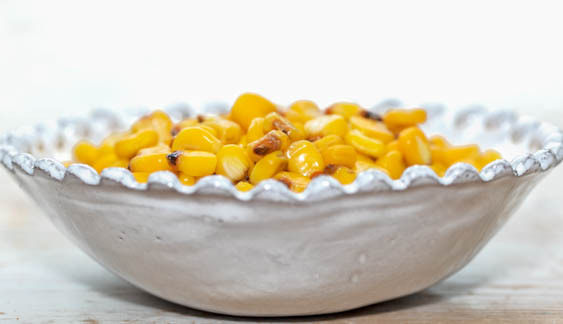Fresh Whole Hominy

introduction
Pre-Columbian Americans regarded everything they grew and cooked as sacred and alive, everything within their cooking sphere bound by nature and magic. A breeze sweeping through wood ashes into a pot of simmering corn became the magic that transformed the familiar flavor of sweet corn into layers of mineral and clove with floral notes. The corn ground easily into meal and made flatbreads that were soft and pliable, not brittle.
Today, corn cooked in limewater is called both nixtamal (a Mexican Spanish adaptation of an Aztec term) and hominy (anglicized Algonquin). Early nixtamal cookery involved wood ash, water, and maize. Properly concentrated, wood ash and water form a naturally caustic chemical called potassium hydroxide (colloquially, potash) that dissolves the cellophane-esque envelope covering the corn called pericarp straight off the kernels. Today, more often than not, culinary lime, a white powder purified from natural calcium deposits, takes the place of the water-and-ash brew. Hominy kernels are plump and infused with an intoxicating flavor that is part corn, part exotic spice, and part mysterious scents that seem to alert your primal sensors to expect exceptional nutrition.
Fresh hominy can be used whole, as in hominy fried in brown butter and herbs, or ground into masa to make tortillas. It can be included as a bright accent in soups and stews or deep-fried to a supple yet crisp result. It also freezes well, maintaining its unique and exceptional character.
Cooking Remarks
Lime is caustic and should not come into prolonged contact with your skin. If you touch culinary lime in dry or liquid form, rinse the area with cold water. Rinse utensils and pots and clean the sink and counters where culinary lime has been present.
Chef-grade calcium hydroxide (culinary lime) is available online from Modernist Pantry.
equipment mise en place
For this recipe, you will need a digital kitchen scale, an 8-quart nonreactive stockpot pot, such as an enamel- or porcelain-coated pot; a stainless-steel spoon; a large bowl; and a colander.
-
-
1gallon distilled water
-
0.8ounce chef-grade calcium hydroxide (see Cooking Remarks)
-
1
-
1pound ice cubes
-
-
Fill an 8-quart nonreactive pot (such as an enamel- or porcelain-coated pot) with the water and set it over high heat. As the water heats, sprinkle the calcium hydroxide over the surface and stir with a stainless-steel spoon to dissolve. When the water reaches a boil, drop the corn into the pot. Return the water to a simmer, stirring frequently. Partially cover the pot, reduce the heat, and cook the corn, stirring frequently and adjusting the burner to maintain a gentle but steady simmer, for 45 minutes. At this point, test the corn for doneness: using a slotted spoon, transfer a few kernels to a bowl of water to rinse them. Remove the kernels from the water, then cut them in half with a sharp paring knife. At ideal doneness, the knife will easily cut through the outside of kernel and the white starchy endosperm in the center will offer medium resistance. Chefs call this medium-rare. If the corn is not yet done, test every 10 minutes or so until it is. The kernels should remain intact and the little brown nibs, or tipcaps, should remain attached, retaining the general appearance of “corn nuts.” Anson Mills hominy corn will take about 1 hour to cook.
-
Pour the corn along with the limewater—which will be thick and milky with dissolved pericarp—into a large bowl. Add the ice and stir. Let stand overnight at room temperature.
-
The following morning, drain the hominy in a colander set in the sink, with tap water running straight onto the kernels to rinse away dissolved pericarp. Rinse the hominy until plump and shiny, then drain well. The hominy will keep in an airtight container or zipper-lock bag in the refrigerator for up to 1 week or may be frozen for up to 3 months.